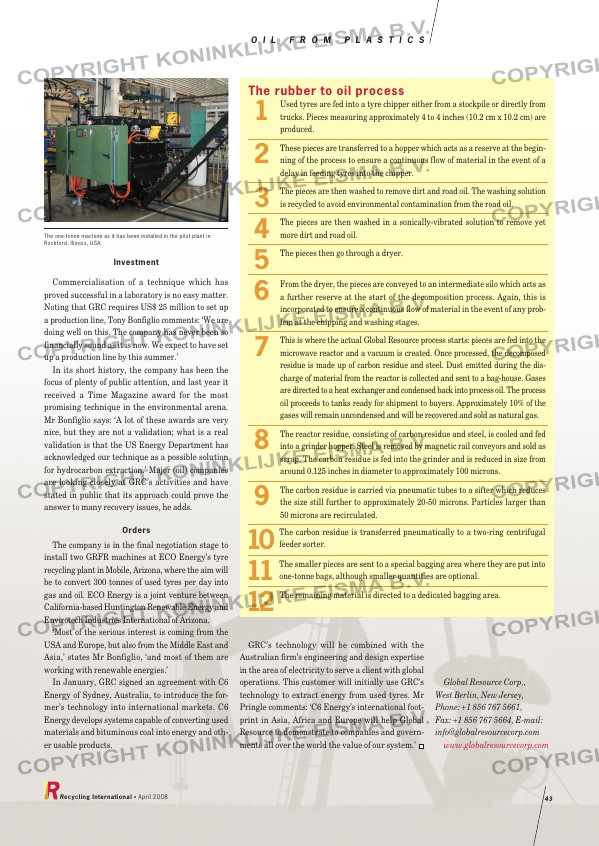Page 43 from: April 2008

GRC’s technology will be combined with the
Australian firm’s engineering and design expertise
in the area of electricity to serve a client with global
operations. This customer will initially use GRC’s
technology to extract energy from used tyres. Mr
Pringle comments: ‘C6 Energy’s international foot-
print in Asia, Africa and Europe will help Global
Resource to demonstrate to companies and govern-
ments all over the world the value of our system.’
O I L F R O M P L A S T I C S
Recycling International • April 2008 43
Investment
Commercialisation of a technique which has
proved successful in a laboratory is no easy matter.
Noting that GRC requires US$ 25 million to set up
a production line, Tony Bonfiglio comments: ‘We are
doing well on this. The company has never been so
financially sound as it is now. We expect to have set
up a production line by this summer.’
In its short history, the company has been the
focus of plenty of public attention, and last year it
received a Time Magazine award for the most
promising technique in the environmental arena.
Mr Bonfiglio says: ‘A lot of these awards are very
nice, but they are not a validation; what is a real
validation is that the US Energy Department has
acknowledged our technique as a possible solution
for hydrocarbon extraction.’ Major (oil) companies
are looking closely at GRC’s activities and have
stated in public that its approach could prove the
answer to many recovery issues, he adds.
Orders
The company is in the final negotiation stage to
install two GRFR machines at ECO Energy’s tyre
recycling plant in Mobile, Arizona, where the aim will
be to convert 300 tonnes of used tyres per day into
gas and oil. ECO Energy is a joint venture between
California-based Huntington Renewable Energy and
Envirotech Industries International of Arizona.
‘Most of the serious interest is coming from the
USA and Europe, but also from the Middle East and
Asia,’ states Mr Bonfiglio, ‘and most of them are
working with renewable energies.’
In January, GRC signed an agreement with C6
Energy of Sydney, Australia, to introduce the for-
mer’s technology into international markets. C6
Energy develops systems capable of converting used
materials and bituminous coal into energy and oth-
er usable products.
The rubber to oil process
1 Used tyres are fed into a tyre chipper either from a stockpile or directly fromtrucks. Pieces measuring approximately 4 to 4 inches (10.2 cm x 10.2 cm) are
produced.
2 These pieces are transferred to a hopper which acts as a reserve at the begin-ning of the process to ensure a continuous flow of material in the event of a
delay in feeding tyres into the chipper.
3 The pieces are then washed to remove dirt and road oil. The washing solutionis recycled to avoid environmental contamination from the road oil.
4 The pieces are then washed in a sonically-vibrated solution to remove yetmore dirt and road oil.
5 The pieces then go through a dryer.
6 From the dryer, the pieces are conveyed to an intermediate silo which acts asa further reserve at the start of the decomposition process. Again, this is
incorporated to ensure a continuous flow of material in the event of any prob-
lem at the chipping and washing stages.
7 This is where the actual Global Resource process starts: pieces are fed into themicrowave reactor and a vacuum is created. Once processed, the decomposed
residue is made up of carbon residue and steel. Dust emitted during the dis-
charge of material from the reactor is collected and sent to a bag-house. Gases
are directed to a heat exchanger and condensed back into process oil. The process
oil proceeds to tanks ready for shipment to buyers. Approximately 10% of the
gases will remain uncondensed and will be recovered and sold as natural gas.
8 The reactor residue, consisting of carbon residue and steel, is cooled and fedinto a grinder hopper. Steel is removed by magnetic rail conveyors and sold as
scrap. The carbon residue is fed into the grinder and is reduced in size from
around 0.125 inches in diameter to approximately 100 microns.
9 The carbon residue is carried via pneumatic tubes to a sifter which reducesthe size still further to approximately 20-50 microns. Particles larger than
50 microns are recirculated.
10
11
12 The remaining material is directed to a dedicated bagging area.
Global Resource Corp.,
West Berlin, New Jersey,
Phone: +1 856 767 5661,
Fax: +1 856 767 5664, E-mail:
[email protected]
www.globalresourcecorp.com
The carbon residue is transferred pneumatically to a two-ring centrifugal
feeder sorter.
The smaller pieces are sent to a special bagging area where they are put into
one-tonne bags, although smaller quantities are optional.
The one-tonne machine as it has been installed in the pilot plant in
Rockford, Illinois, USA.
RI_052 OIL plastic:Opmaak 1 03-04-2008 15:31 Pagina 43



